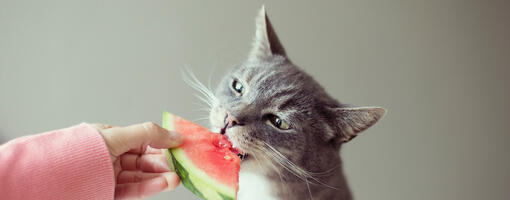
For people, fruits are essential to a healthy diet and while an apple a day keeps the doctor away, does it go the same way in the case of our feline friends? If you’ve ever been tempted to share your fruit bowl with your furry friend, you’ve probably wondered: “what fruits can cats eat?”. Well, quite a few, it turns out.
Many of the fruits we consume are also safe to be eaten by cats. They can be a great source of vitamins, as well as a refreshing snack for our feline friends. Their sweet taste, however, is not a reason why your cat might enjoy it. Unlike us, cats don’t have sweet taste receptors, so at most, they will like the fruit for their texture or smell. Although they can be rich in vitamins, only very small amounts of fruit should be offered as a treat, since cat food already contains all the nutrients and vitamins they need. The digestive system of cats is designed to absorb a meat-based diet, so their nutritional needs will not be met if they have more than a small amount of other foods.
If you want your cat to try out fruit, it’s important to know which are safe for them to eat and how to prepare them. Remember to always feed your cat a balanced diet and consult the vet before adding new foods to it. Feeding fresh fruit is generally better for cats than tinned or processed fruit which may contain additives or preservatives that would not be good for them. Also remember that whenever you feed unfamiliar food to your cat, start by introducing a little bit at a time and watch out for side effects such as vomiting or diarrhoea or skin rash.
What fruits can cats eat?
To help you make sure your cat enjoys fruit and stays safe, we put together a list of the type and parts of fruit they can consume. Check them out:
Apples (removing the seeds and stem)
A staple of all diets, apples are high in fibre, Vitamins K, A, and C, as well as antioxidants and calcium. Their crunchy texture can also be appealing to your cat and since they’re roughly 86% water, they can be great for hydration too.
When offering apples to your cat, always remove the stem and seeds as they might contain small amounts of cyanide, a chemical that’s toxic to cats and other animals. It’s best to cut the apples in tiny slices or cubes and only serve 1 or 2 pieces.
Bananas
Rich in vitamins B6 and C, bananas contain potassium and carbs, great for muscles and blood pressure. However, because they’re high in sugar, it’s recommended to only offer them in moderation.
Cut bananas in 3 cm slices and offer them either fresh or frozen (they might enjoy the crunch better) but stick to no more than 1 or 2 pieces.
Mangos
One of the most exotic fruits, mangoes are high in fibre, Vitamin C, A, and B6. They’re packed with nutrients and can contribute to your cat’s digestive health, as well as eye health. As with other fruit, they should have their pit and peel removed before serving as they can be toxic for your cat. Mangos are great as snacks and your cat can safely enjoy about 1-2 small slices per day.
Strawberries
Strawberries are a favourite among many pets and an excellent source of potassium and fibre. They are also rich in Vitamin C, B1, B6, antioxidants and folate. These tasty tiny red fruits can be a great boost for your cat’s immunity.
To make sure strawberries are safe for your cat, wash them carefully to remove all traces of dirt and cut out the stems and leaves. You should not serve more than 1-2 pieces to your cat but you can opt for either offering them strawberries fresh, frozen, or mashed.
Pineapple
High in vitamins and minerals like magnesium and potassium, pineapple can help support your cat’s digestive and immune system. However, they’re also high in fructose so only feed your cat small amounts of it, and only after removing the prickly skin and peel.
If you’d rather go for canned pineapple, this is also safe but keep in mind that it might contain preservatives which are not great for cats. Raw and fresh pineapple would be the best of the two options.
Berries
Most types of berry, as a matter of fact, can be incorporated in your cat’s diet. Blueberries, blackberries and cranberries are all safe for cats to consume as they’re high in vitamins, fibre, and antioxidants. Don’t forget to cut them into small pieces and stick to 2-3 berries per day. These can be a great support in reducing the risk of UTIs and maintaining eye health ,find out why your cat’s eyes are watering with our expert guide.
Cantaloupe Melon
Cantaloupe contains Vitamins A, C, B, and beta-carotene, which helps with vision. They’re also high in water and low in calories, making them great for cats that are not consuming enough liquids. It’s possible that your cat will also love it because of its scent which is similar that of proteins in meat.
To serve it, cut a small piece into cubes and make sure you’re removing the rind before offering it to your cat.
Pears
Rich in copper, vitamins, and fibre, pears can help prevent infections in cats and boost immunity. They’re also high in sugar so they should only be offered in small amounts.
After removing the core and seeds, cut the pear into small pieces and serve 2-3 of them to your cat – they’re sure to enjoy it, especially if it’s got a bit of crunch to it.
Apricots
Tasty and perfect on a hot, summer day, apricots can be a great addition to your cat’s diet. Cut up a slice after removing the stem, pit, and leaves, and watch how it becomes one of your feline friend’s favourite snacks.
Watermelon
Another useful fruit for cats that don’t consume enough liquids, watermelons are basically textured water. They’re also packed with potassium, Vitamins A, B, and C, making them a superfruit that helps support normal blood pressure. It’s a good idea to only feed seedless watermelon to your cat and remove the rind before serving it.
Want to know more about what you should feed your cat? Check out this article on feeding your adult cat and learn all there is to know about incorporating the right nutrients into your feline friend’s diet.
Not all foods are safe for feeding your cat. Learn more about the harmful substances and poisonous foods for cats.












